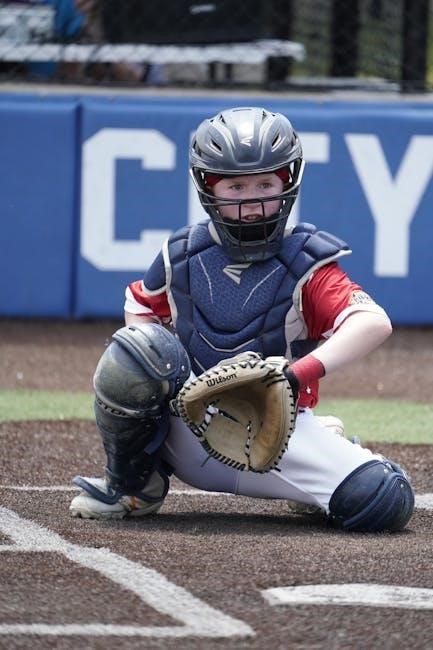Little League Shoulder is a common injury in young pitchers, caused by repetitive stress on the growth plates. This article provides a comprehensive rehabilitation protocol to ensure safe recovery and return to play, focusing on structured exercises and gradual progression.
1.1 Overview of Little League Shoulder
Little League Shoulder, or proximal humeral epiphysitis, is a common overuse injury in young pitchers. It occurs due to repetitive stress on the growth plates of the shoulder, leading to pain and inflammation. This condition primarily affects athletes aged 11–16, particularly those involved in repetitive throwing sports. The injury is often linked to poor pitching mechanics, overuse, or inadequate rest. Early diagnosis and proper rehabilitation are crucial to prevent long-term damage and ensure a safe return to play. This overview highlights the importance of understanding the injury’s nature and the need for structured rehabilitation protocols to address it effectively.
1.2 Importance of Rehabilitation Protocols
Rehabilitation protocols are essential for managing Little League Shoulder, ensuring a safe and effective recovery. These structured plans help restore shoulder strength, flexibility, and function, reducing the risk of recurrence. Proper protocols address the root causes, such as poor mechanics and overuse, promoting long-term health. They also guide athletes through gradual progression, preventing premature return to play. Adherence to these protocols minimizes complications and supports the athlete’s ability to resume their sport confidently. A well-designed rehab program is vital for young athletes, fostering optimal recovery and maintaining their athletic potential.
Definition and Pathophysiology
Little League Shoulder, or proximal humerus epiphyseal injury, occurs due to repetitive stress on the growth plates, leading to microfractures and inflammation in young pitchers.
2.1 What is Little League Shoulder?
Little League Shoulder, or proximal humerus epiphyseal injury, is a common overuse injury in young pitchers. It occurs due to repetitive stress on the growth plates, leading to microfractures and inflammation. The injury specifically affects the medial epicondylar apophysis, causing pain and swelling near the elbow. It is often associated with improper pitching mechanics and excessive throwing. Early diagnosis is crucial to prevent further damage and ensure proper recovery. The condition is unique to the skeletally immature, making it a significant concern in youth baseball. Understanding its definition is key to developing effective rehabilitation strategies.
2.2 Pathophysiology of the Injury
Little League Shoulder primarily results from repetitive stress on the proximal humerus, leading to microfractures in the growth plates. The injury occurs due to the vulnerability of the medial epicondylar apophysis, which is still developing in young athletes. Overuse causes inflammation and pain, particularly during pitching motions. The growth plates are weaker than surrounding tissues, making them prone to injury. This repetitive stress disrupts normal bone growth, leading to structural changes and discomfort. Understanding the injury’s pathophysiology is essential for developing targeted rehabilitation strategies to restore function and prevent long-term damage.

Causes and Risk Factors
Overuse, repetitive pitching, and poor mechanics are primary causes. Inadequate rest, excessive pitch counts, and improper training contribute to the risk of developing Little League Shoulder.
3.1 Overuse and Repetitive Stress
Overuse and repetitive stress are central to Little League Shoulder, often due to excessive pitching without adequate rest. Young athletes, especially pitchers, frequently throw beyond their body’s capacity, leading to strain on the proximal humeral epiphysis. The repetitive motion of pitching creates cumulative stress, weakening the growth plate and causing microfractures. This stress is exacerbated by improper pitching mechanics and insufficient recovery time. Coaches and parents must monitor pitch counts and ensure adherence to guidelines to prevent such injuries. Early recognition of overuse symptoms is crucial to avoid prolonged damage and facilitate timely intervention.
3.2 Poor Pitching Mechanics
Poor pitching mechanics significantly contribute to Little League Shoulder, as improper techniques increase stress on the shoulder joint. Common issues include dropping the elbow below shoulder height, excessive arm cocking, and poor follow-through. These flaws alter the biomechanics of pitching, placing additional strain on the proximal humerus. Coaches and trainers play a vital role in identifying and correcting these mechanical errors. Proper training and adherence to biomechanical principles can reduce the risk of injury. Addressing pitching mechanics early helps prevent repetitive stress and promotes long-term shoulder health in young athletes. Emphasizing proper form is essential for injury prevention and effective performance.
Symptoms and Diagnosis
Symptoms include pain during pitching, especially with overhead throws. Diagnosis involves physical exams, X-rays, and sometimes MRIs to confirm growth plate fractures or inflammation.
4.1 Common Symptoms in Young Athletes
Young athletes with Little League Shoulder often experience pain during pitching, particularly with overhead throws. Swelling or tenderness around the shoulder may be present. Limited range of motion and weakness in the affected arm are common. Pain typically worsens with activity and improves with rest. Some athletes may exhibit difficulty in performing pitching motions or other overhead activities. Early recognition of these symptoms is crucial for timely intervention and prevention of further injury. If left untreated, the condition can lead to prolonged recovery and potential long-term damage to the growth plates.

4.2 Diagnostic Procedures and Tests
Diagnosing Little League Shoulder involves a combination of physical examination and imaging studies. A thorough medical history and physical exam are conducted to assess pain, swelling, and limited range of motion. X-rays or MRIs may be used to confirm the presence of growth plate fractures or other structural abnormalities. Strength and mobility tests are also performed to evaluate shoulder function. In some cases, comparative assessments of both shoulders may be done to identify asymmetries. Accurate diagnosis is essential to guide appropriate treatment and prevent further complications. Early detection ensures timely intervention, promoting optimal recovery and return to athletic activities.

Treatment Options
Treatment for Little League Shoulder typically involves conservative approaches, including rest, physical therapy, and anti-inflammatory medications. Surgery is rarely needed but may be considered in severe cases.
5.1 Conservative Management Strategies
Conservative management is the primary approach for treating Little League Shoulder, focusing on reducing pain and inflammation while promoting healing. This typically includes rest from throwing activities, ice therapy to reduce swelling, and anti-inflammatory medications. Physical therapy plays a crucial role, emphasizing shoulder strengthening, flexibility exercises, and scapular stabilization. A gradual return to activity is essential, with a structured rehab program to restore strength and mobility. These strategies aim to address the injury without surgical intervention, ensuring young athletes can safely recover and return to their sport. Proper adherence to these protocols is vital to prevent further complications and promote long-term shoulder health.
5.2 Surgical Interventions (if necessary)
Surgical intervention is rarely required for Little League Shoulder but may be considered if conservative treatments fail to resolve symptoms or if there is significant structural damage. Procedures often involve debridement of the affected growth plate or fracture repair to stabilize the area. Surgery is typically reserved for severe cases where the growth plate is fractured or significantly disrupted. Post-operative rehabilitation is critical, focusing on restoring range of motion, strength, and function. Surgical recovery may take several months, with a gradual return to activity to prevent recurrence. The goal is to restore shoulder health and ensure the athlete can safely return to their sport.
Rehabilitation Protocol Overview
A structured approach to restore strength, mobility, and function in young athletes with Little League Shoulder, focusing on gradual progression and ensuring a safe return to play.
6.1 Phases of Rehabilitation

The rehabilitation process for Little League Shoulder is divided into four distinct phases. The acute phase focuses on pain management and basic mobility. The strengthening phase builds shoulder stability and muscle endurance. The advanced strengthening phase introduces dynamic exercises and sport-specific movements. Finally, the return-to-play phase ensures athletes are ready for full participation. Each phase is designed to progressively restore function, strength, and mobility, minimizing the risk of re-injury while preparing the athlete for a safe return to their sport.
6.2 Key Components of the Rehab Program
The rehabilitation program for Little League Shoulder includes rest and ice therapy to reduce inflammation, followed by range of motion exercises to restore shoulder mobility. Scapular and shoulder strengthening exercises are introduced to improve stability and endurance. Progressive resistance exercises and dynamic stabilization help enhance strength and control. Sport-specific drills simulate pitching movements to prepare for return to play. Each component is tailored to the athlete’s progress, ensuring a balanced approach to recovery and preventing future injuries. The program emphasizes gradual progression to avoid overloading the shoulder joint during the healing process.
Phase 1: Acute Phase (0-2 weeks)
This phase focuses on rest and ice therapy to reduce inflammation and pain. Initial range of motion exercises are introduced to maintain shoulder mobility without overloading the joint.
7.1 Rest and Ice Therapy
Rest and ice therapy are critical during the acute phase of Little League Shoulder rehabilitation. Athletes must avoid any activities that exacerbate pain or stress the injured area. Ice should be applied for 15-20 minutes, 3-4 times daily, to reduce inflammation and alleviate discomfort. This approach, often referred to as the RICE principle (Rest, Ice, Compression, Elevation), helps minimize swelling and promotes healing. Proper rest prevents further damage to the growth plates, while ice therapy manages pain and inflammation effectively. Monitoring pain levels and maintaining joint mobility through gentle, non-painful movements are also essential during this initial recovery period.
7.2 Initial Range of Motion Exercises
Initial range of motion exercises are essential to maintain shoulder mobility during the acute phase of rehabilitation. Gentle, pain-free movements are introduced to prevent stiffness without exacerbating the injury. Exercises such as pendulum swings and passive forward elevation are commonly recommended. These activities should be performed 2-3 times daily, focusing on controlled, slow movements. The goal is to gradually restore normal shoulder mechanics while avoiding pain. Progression is based on symptom improvement, ensuring the athlete does not experience discomfort. These exercises lay the groundwork for more advanced strengthening phases, promoting a smooth transition to active recovery and eventual return to play.
Phase 2: Strengthening Phase (2-6 weeks)
Phase 2 focuses on strengthening the shoulder and scapular muscles through targeted exercises, enhancing stability and strength to support the injured area during recovery.
8.1 Scapular and Shoulder Strengthening
During this phase, exercises focus on enhancing scapular stability and shoulder strength to restore proper mechanics. Scapular push-ups, shoulder blade squeezes, and lateral raises are commonly used. Resistance bands or light weights may be incorporated to progress resistance. Emphasis is placed on controlled movements to avoid exacerbating the injury. Strengthening the rotator cuff muscles, such as the supraspinatus and subscapularis, is critical for improving joint stability. These exercises help reduce the risk of recurrence and prepare the athlete for more dynamic movements in later phases. Consistency and proper form are essential to ensure effective rehabilitation and a safe return to pitching.
8.2 Progressive Resistance Exercises
Progressive resistance exercises are integral to strengthening the shoulder and scapular muscles. These exercises involve gradually increasing resistance, often using resistance bands or light weights, to build strength and endurance. They target key muscles like the rotator cuff and deltoids, improving joint stability and reducing injury risk. Exercises such as shoulder rotations, lateral raises, and internal/external rotations are commonly used. The resistance is progressively increased as the athlete’s strength improves, ensuring continuous challenge and adaptation. This approach helps restore normal movement patterns and prepares the athlete for more dynamic activities, making it a cornerstone of the strengthening phase in rehabilitation protocols.

Phase 3: Advanced Strengthening and Mobility
Phase 3 focuses on enhancing strength, mobility, and dynamic stability. It introduces advanced exercises to improve functional movement and prepare the athlete for sport-specific activities.
9.1 Dynamic Stabilization Exercises
Dynamic stabilization exercises are designed to enhance shoulder joint stability and neuromuscular control. These exercises involve controlled movements that challenge the shoulder’s ability to maintain proper positioning during motion. Examples include shoulder blade squeezes, bird dogs, and dynamic plank variations. Resistance bands or light weights may be incorporated to increase difficulty. The goal is to improve functional strength and prevent excessive movement in the shoulder joint, which is critical for pitchers returning to throwing. These exercises are typically performed in a controlled environment, with a focus on maintaining proper form and engaging the core for stability.
9.2 Sport-Specific Drills
Sport-specific drills are integral to advanced rehabilitation, focusing on movements that mimic pitching and throwing. These drills aim to restore functional strength, timing, and accuracy. Examples include short toss, long toss, and bullpen sessions, starting at low intensity and progressing gradually. Resistance bands and plyometric exercises may be incorporated to enhance power and control. The drills are tailored to the athlete’s specific sport demands, ensuring a smooth transition back to competitive play. Coaches and trainers closely monitor technique to prevent re-injury. The goal is to rebuild confidence and performance capabilities, preparing the athlete for the dynamic nature of their sport.

Phase 4: Return to Play
This phase focuses on gradual reintegration into sport-specific activities, ensuring the athlete meets functional and strength criteria. Progression is monitored to confirm readiness for full participation.
10.1 Functional Assessments
Functional assessments are critical to determine an athlete’s readiness for return to play. These evaluations focus on measuring shoulder strength, range of motion, and stability. Key components include shoulder rotation strength tests, scapular stability assessments, and functional movement screens. Athletes must demonstrate symmetrical strength and pain-free mobility compared to the uninjured side. Clinicians also evaluate pitching mechanics to ensure proper form and reduce reinjury risk. These assessments guide the progression to unrestricted participation, ensuring the athlete has achieved full functional recovery and is prepared for the demands of competitive play.
10.2 Gradual Return to Pitching

A gradual return to pitching is essential to prevent reinjury and ensure long-term recovery. Athletes begin with light tossing at short distances, progressing to longer throws and increased intensity. Pitch counts are strictly monitored, with gradual increases in volume and velocity. Emphasis is placed on proper mechanics and pain-free performance. Athletes are allowed to advance only when they demonstrate consistent control and effortless delivery. Rest periods between sessions are crucial to avoid overloading the shoulder. Coaches and trainers closely observe for any signs of fatigue or discomfort, ensuring a safe transition back to competitive pitching.
Prevention Strategies
Prevention strategies focus on reducing repetitive stress and promoting proper pitching mechanics. Adhering to pitch count guidelines, strength training, and monitoring workload are key to minimizing injury risk in young athletes.
11.1 Pitch Count Guidelines
Pitch count guidelines are essential for preventing overuse injuries in young pitchers. These guidelines limit the number of pitches an athlete can throw per game and season. For example, pitchers aged 8-10 are often restricted to 50-75 pitches per game, while older athletes may have higher limits. Proper enforcement of these guidelines helps reduce repetitive stress on the shoulder and elbow, minimizing the risk of injuries like Little League Shoulder. Coaches and parents must adhere to these rules to ensure the long-term health and performance of young athletes. Consistent monitoring and strict adherence are crucial for effective injury prevention.

11.2 Proper Training and Mechanics
Proper training and mechanics are critical in preventing Little League Shoulder. Coaches should emphasize correct pitching techniques, such as proper arm angles, leg drive, and follow-through, to reduce stress on the shoulder. Young athletes should avoid improper mechanics like throwing across their body or using a sidearm motion. Strength and flexibility exercises targeting the shoulder and scapular muscles are also essential. Additionally, educating players and parents about the importance of proper form can help prevent overuse injuries. By focusing on biomechanics and technique, coaches can create a safer environment for young pitchers to develop their skills effectively.

Role of Coaches and Trainers
Coaches and trainers play a vital role in preventing injuries by educating athletes on proper mechanics, monitoring workload, and enforcing pitch count guidelines to ensure safe participation.
12.1 Education on Injury Prevention
Coaches and trainers should educate young athletes on proper pitching mechanics, warm-up routines, and the importance of rest. They must emphasize adhering to pitch count guidelines and recognizing early signs of fatigue or pain. By fostering a culture of safety and awareness, they can significantly reduce the risk of Little League Shoulder and other injuries. This proactive approach ensures athletes understand the long-term benefits of injury prevention, promoting sustainable participation in sports. Continuous education and open communication are key to maintaining healthy and injury-free athletes throughout their careers.
12.2 Monitoring Athlete Workload
Monitoring athlete workload is crucial to prevent overuse injuries like Little League Shoulder. Coaches and trainers should track pitch counts, innings pitched, and rest periods to ensure adherence to guidelines. Regularly assessing an athlete’s physical and mental fatigue is essential. Adjusting practice and game schedules based on individual needs helps prevent burnout. Encouraging open communication about pain or discomfort allows for early intervention. Proper workload management not only reduces injury risk but also enhances performance and longevity in the sport. By prioritizing athlete well-being, coaches can foster a safe and effective training environment.
Nutrition and Recovery
Proper nutrition and recovery are vital for healing and preventing Little League Shoulder. A balanced diet rich in protein, calcium, and vitamin D supports bone and muscle repair. Hydration is essential for joint health and recovery. Anti-inflammatory foods like fish, nuts, and berries can reduce swelling. Post-workout nutrition, including carbohydrates and protein, aids muscle recovery. Adequate sleep and rest are critical for growth and tissue repair in young athletes. Supplements, such as omega-3 fatty acids, may help reduce inflammation. A well-nourished body accelerates the rehabilitation process, ensuring a stronger return to sports. Nutrition plays a key role in overall recovery and injury prevention.
